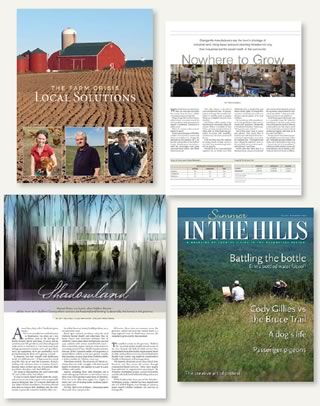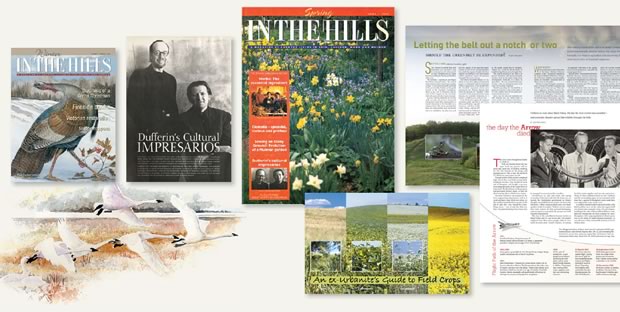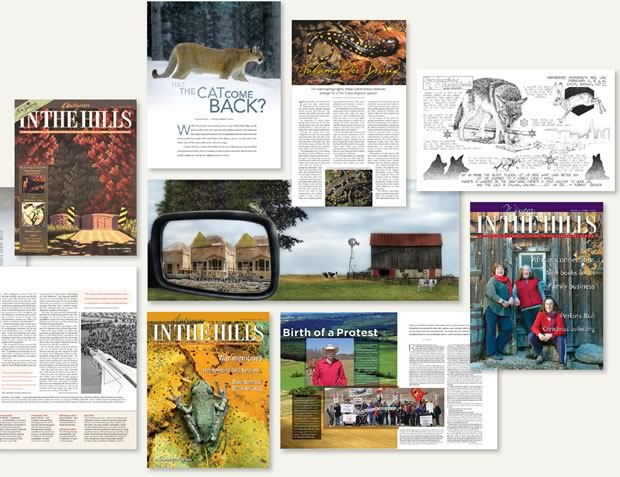A Greater Conversation
In an era when newspapers are being shuttered around the globe, and despite the oft-repeated claim that “print is dead,” In The Hills has not only survived, but prospered.
It’s depressing” was publisher/editor Signe Ball’s typically wry comment as she gave me 80 copies of In The Hills – one of each issue ever produced – to prepare this retrospective. “Twenty years of my life, and it all fits in two shopping bags.”
Well, Signe, to begin with, they’re big shopping bags. Beyond that, looking back over 80 issues of In The Hills, I can confirm that the sum total of your last two decades is worth far more, as the saying goes, than the paper it’s written on.
That fact was plainly obvious right from the start. Early reader Anna Marie Holtom wrote, “In my opinion, this is the best magazine this community has ever had the privilege of receiving. It is well written, informative, interesting, up-to-date, attractive and just plain great. I look forward to receiving each issue and read it cover to cover.” Although these sentiments have been repeated over and over again in the years since, Signe notes they are not something she ever tires of hearing. In fact, the enthusiasm of its readers is the animating spirit of the magazine.
In an era when newspapers are being shuttered around the globe, and despite the oft-repeated claim that “print is dead,” In The Hills has not only survived, but prospered. Indeed, it has done more than that. Several other regional magazines have since popped up around southern Ontario bearing a striking resemblance to the quarterly format that In The Hills pioneered.
Another measure of In The Hills’ success lies in the talented team of writers, artists, photographers, designers and advertising professionals – almost all of them local residents – who year in and year out are responsible for the compelling content of a publication that can be compared confidently to any of the offerings from the glass and chrome towers in the Big Smoke.
That inaugural issue, nervously sent out into the world in the spring of 1994, was a slim 24 pages – this issue is over 100 – and nearly all the ads were black and white, but it had an immediate impact. Advertisers began calling the day it hit the street, and a surprising number of those who took a chance on that first issue still regularly appear in the magazine, including some who have never missed an issue.
As realtor and long-time advertiser Jamie Gairdner recently put it, “I can’t possibly think of another magazine that has the shelf life that In The Hills does. The articles are interesting, people want to read them, and so do the friends who come to visit them.”
The Three Amigos of Arts and Culture
There must have been something in the water in the early ’90s. That first issue of In The Hills in 1994 included a feature about the launch of Dufferin County Museum and Archives as well as Theatre Orangeville. Since then the trio have all found a place in the cultural mainstream of the community – and have remained fast friends. Indeed, this fall all three will come together to mark their two decades jointly at a weekend-long celebration at the museum during Headwaters Arts Festival. (As it happens, Signe co-founded the festival, and the magazine has continued to be a major sponsor.)
Since that first issue, coverage of local arts and culture has remained an essential editorial focus of In The Hills. Over the years, more than 250 local artists have been featured in some way in the magazine’s pages. And beyond visual arts, there has been ample coverage of music, dance, theatre, film and literature. Tracey Fockler’s annual review of new books published by local authors continues to keep us abreast of what our neighbours are writing, and Lisa Watson’s annual review of new tunes by local musicians keeps us listening.
As Signe says, “It’s been said so often, it may sound trite, but the truth is the arts do represent the soul of the community, and give us a different, more expansive way of seeing and interpreting our world.”
Captives on the Carousel of Time
Paying tribute to the region’s heritage has also been an editorial priority for In The Hills. “Since I began publishing the magazine 20 years ago, the population of Headwaters has nearly doubled,” Signe says. “So that means about 50 per cent of the population are relative newcomers, most of whom have made an active lifestyle decision to come here, often in search of a life more rooted in a smaller community and the natural landscape. As part of that, they seem to have a more insatiable appetite for the history of the place than many of those who have lived here longer.”
Most of that history is delivered via Ken Weber’s “Historic Hills.” Ken first contributed a story in the summer of 1996, describing how the birth of Canada was celebrated in the hills – and that was the start of what has become the magazine’s longest-running regular column. He has written more than 60 of them, covering everything from a bank robbery gone awry in Shelburne, to the introduction of the first automobiles, to the day Tom Longboat raced in Erin. Ken also contributes the back page puzzles that keep us all guessing.
Among the feature stories on area history was one I wrote in 2009, marking 50 years since the cancellation of the Avro Arrow and the devastating impact that had on the many residents of the hills who worked on the project. That story garnered more response from readers than any I’ve done in eight years with the magazine, and I admit I was astounded to discover that, even five decades later, the pain of that fateful decision is still very much alive.
Amorous Amphibians, and Other Earthy Matters
No subject has received as much ink in this magazine as the environment. “The trees, the hills, the wildlife, the water, the meadows and the farm fields, they are the very reasons most of us choose to live here,” Signe says. “And from day one, In The Hills has been unapologetically biased in favour of preserving and protecting them.”
The magazine’s first story on concerns surrounding aggregate mining appeared in 1997. It was written by biologist Nicola Ross, who went on to cover a variety of environmental issues, often bringing a local perspective to global concerns. In 1998 she wrote a story called “The Borders of Paradise” about the conflict between rural values and urban sprawl. In 1999 her topic was about rethinking the concept that growth necessarily equals prosperity. A witty quip by former Mono mayor John Creelman still strikes a chord: “Quality of life is not necessarily measured by the size of your sewage system.”
Nicola’s story in the fall 2001 issue called “Reducing Caledon’s Ecological Footprint” won a Silver National Magazine Award. And, although it’s hard to believe now, her 2002 story on local evidence of climate change was written before “climate change” had entered the everyday vernacular – so her story took pains to define it, along with such terms as “global warming” and “greenhouse effect.”
Nicola continues to contribute to In The Hills, including two regular columns, “Good Sport” and “Homegrown in the Hills.” However, in recent years, Tim Shuff has picked up the aggregates beat and his thorough, ongoing coverage of the Melancthon quarry became the go-to reference material in the ultimately successful fight to have the proposal quashed. (This issue includes his latest update on the quarry battle.)
Other environmental topics tackled by Nicola, Tim and other writers have ranged from perceived biases at the Ontario Municipal Board, the local impact of such legislation as the Greenbelt and the Growth Plan for the Greater Golden Horseshoe, to ongoing coverage of such subjects as water, garbage and traffic.
But not all the magazine’s environmental coverage has been driven by dire issues. On the lighter side, for example, there was a 2000 story called “An Ex-urbanite’s Guide to Field Crops,” written to give newcomers something to talk about with their farmer neighbours “after you’ve established that it looks like rain.” In fact, the community’s agricultural roots have been featured regularly, including a 2005 issue almost entirely devoted to the topic, and Nicola’s “Homegrown” column which profiles a local producer in every issue.
Among my favourite environmental stories are naturalist Don Scallen’s regular dispatches from the wilds of our countryside. He’s covered all creatures great and small, both flora and fauna, from beavers to snakes, and from cougars (really?) to moths. I particularly enjoyed his salacious look at the love lives of salamanders in the spring 2004 issue. Don is back this issue with two features, on the disparate topics of spring ephemerals and coyotes.
Getting Down to Business
A strong supporter of local independent business, In The Hills frequently covers trends in the local economy that reveal some broader understanding of the enterprise that sustains our community. The first such foray, in the summer of 1994, was a story about home-based businesses, and how local entrepreneurs were using their “microcomputers” and a newfangled invention called “telecomputing.” Mulmur businessman Jim Lorriman anticipated a day when images would be sent through a modem, and “virtually the entire transaction will be accomplished in ‘high-tech style.’” Readers were sagely advised to try connecting to a local bulletin board before “tackling the Internet.”
Eventually we all logged on, and In The Hills was no exception. These days, www.inthehills.ca is not only a place to find stories that have appeared in print, it also has web-exclusive content, and provides an easy place to comment on what you’ve read. And the online calendar is the region’s most comprehensive source of local events.
The magazine has looked at the industrial growth in Orangeville, multigenerational family businesses, the role of general stores, tips on establishing a country career, and in a recent issue, the women who have taken over downtown retail.
Much of its business coverage has focused on agriculture and food. That topic is so broad and integral to the region that in 2011, Food In The Hills was launched as a sister publication entirely devoted to all the best about local food, including who grows it, who serves it, where to buy it and how to cook it.
Of the local movement that inspired the new magazine, Signe says, “Not since feminism has there been such a widespread grassroots movement with the potential to change the way we live our lives in such an intimate way. It intersects our own health and the health of the planet in a very personal place, at our kitchen tables. And it opens possibilities to put small-scale farming back at the centre of the local economy as it once was. Plus, the best part really, it’s so much fun.”
The Good, Bad and Ugly
Reading through Signe’s editorials over the years, I’m struck by the dogged determination with which the magazine remains devoted to preserving our rural lifestyle and sense of community. While it’s true that our culture, history, environment and businesses are all part of that, really it’s about the people.
As one subscriber said, “In the Hills has become must reading for everyone in this area. It has brought us together, and deepened our appreciation of living in this part of Ontario. Love it!” (Signe particularly treasures that comment, not only for the sentiment, but because it came from Michael de Pencier. The former publisher of Toronto Life was Signe’s boss a long, long time ago when she was still very wet behind the editorial ears.)
That sense of community has been expressed in many, many different ways in these pages, from glimpses into the lives of the rich and famous who reside here, such as Norman Jewison and Terry O’Reilly, to homages to the everyday folks who keep our lives ticking, like snowplow operators, school bus drivers and volunteer firefighters.
But perhaps the best example of all that is the local heroes series. Over the last five years it has been my honour to serve as lead writer for the profiles of more than 50 extraordinary people, and several groups, who have all made a significant contribution to this place we call home. They represent a collection of talent, courage, determination and commitment that can take your breath away. And while their activities are as varied as humanity itself, they share the common purpose of making Headwaters a better place.
 At the same time, while many so-called “lifestyle” magazines shy away from anything less than positive, In The Hills has no qualms about tackling stories with darker undertones.
At the same time, while many so-called “lifestyle” magazines shy away from anything less than positive, In The Hills has no qualms about tackling stories with darker undertones.
“In The Hills is in many ways a celebration of the best things about living here,” Signe says, “but our community is as rich and complex as any other. And that means it’s not perfect, so we also want to examine the things that concern us.”
So the magazine has covered hunger and homelessness and the lack of mental health care. And it has reflected on the struggles of single parents and youth living on the street, and explored end-of-life issues and hospice care.
“In this seemingly bucolic setting, so many social ills can be easily hidden and ignored,” Signe says, “and those who suffer from them are often even more isolated and alone than they might be elsewhere. They are important stories to tell if we want an honest picture of life here.”
Taming Wolves and Making Sheep Ferocious
Adlai Stevenson said, “An editor is someone who separates the wheat from the chaff and then prints the chaff.” Well, that’s not the case with In The Hills, and Signe, all of us involved with the magazine owe you a debt of gratitude for your tough editorial love.
I like to tell the tale of an email you once sent me in response to a piece I submitted. The email was a concise review of my story. It read, “A lot of wind, not much content.” I threw the whole thing out and started over.
Some may think that review was harsh, but as a writer it’s very freeing to know that you’re there as a safety net, preventing me from making an ass of myself. It gives me confidence and makes me better at my craft. All of us who contribute, one way or another, are reassured by that knowledge, and it ups our creative game. Everyone, especially readers, benefits as a result.
Photographer Pete Paterson points out something else your little magazine has done. “I thank Signe all the time for giving me so many opportunities to get to know the community in ways that never would have happened without In The Hills,” he told me recently. “She has enriched my life so much.”
And as reader Clare Booker of Erin summarized it in a letter a few issues ago, “In The Hills is consistently thoughtful, relevant, beautiful, informative and ahead of its time. Fantastic leadership and vision, and a commitment to our global community.” Amen.
So there’s just a small sampling of what’s contained in those two shopping bags, Signe. It’s much more than a few sheets of paper. They’re stuffed full with a greater conversation, representing nothing less than the lifeblood of the community. And that’s just what a good magazine should be.










Signe, Congrats on 20 years!!! Amazing!! Always great content and presented in a professional manner and with clarity – history, the environment and current issues! Congrats to the staff too.
Joe Grogan from Bolton Resident, 38 years on Sep 18, 2013 at 10:07 am |